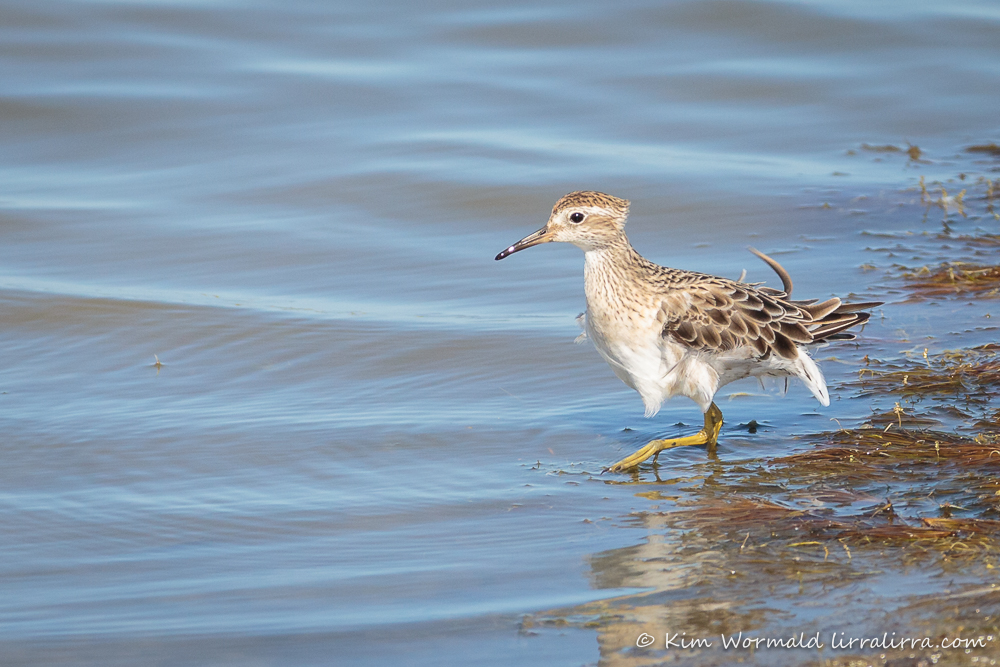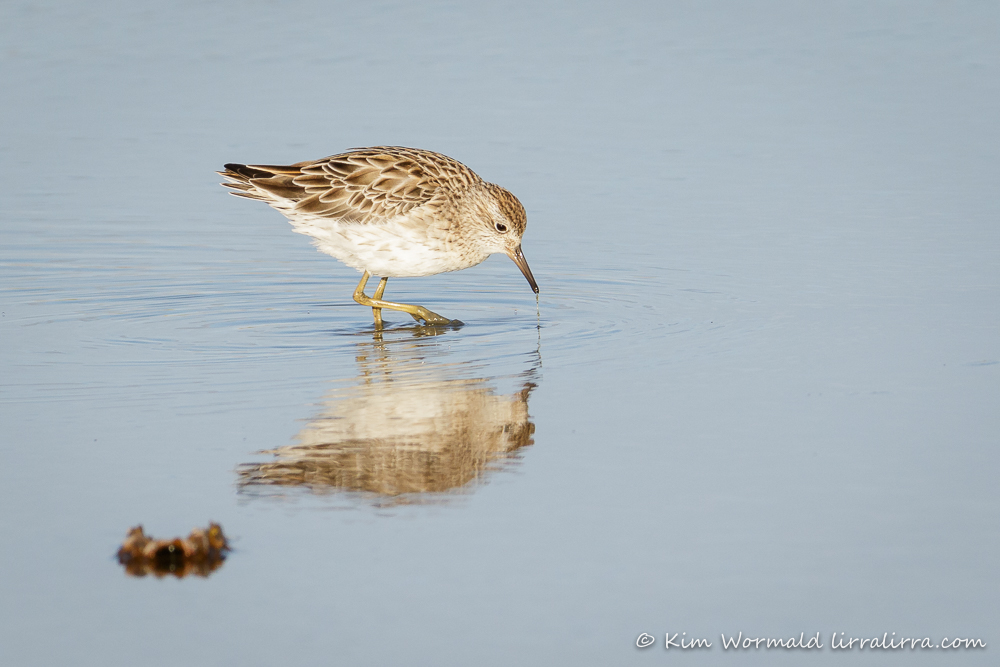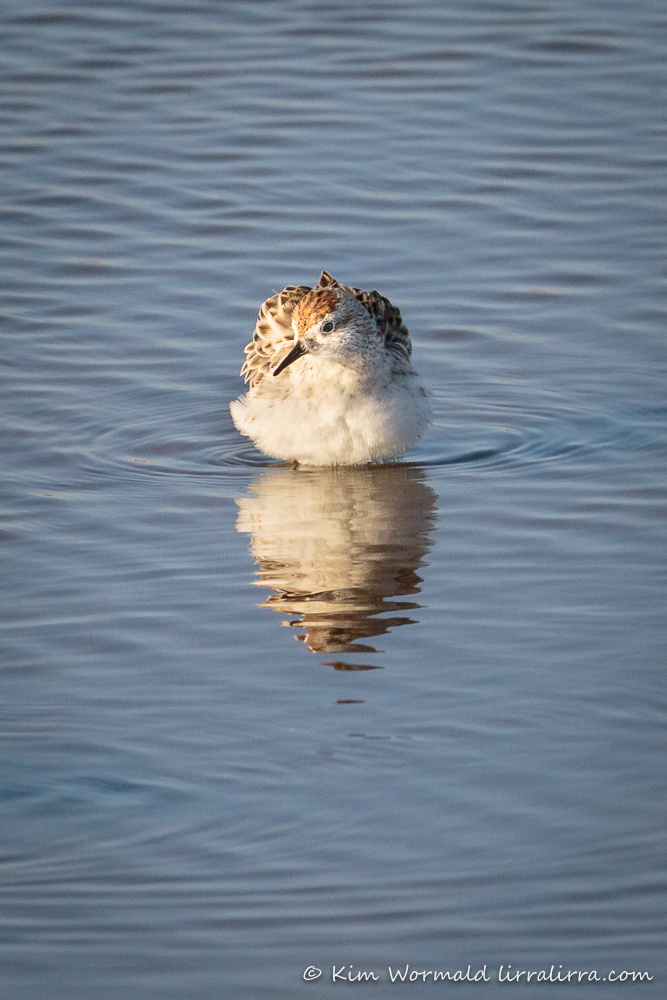If in doubt it’s best practice to err on the side of the more common species, but this bird has puzzled some of our top wader experts.

Sharp-tailed Sandpiper or Pectoral Sandpiper
1/1600, f/7.1, ISO 800
Sharp-tailed Sandpipers are common waders, shown in both images below, while Pectoral Sandpipers are significantly rarer. I can ID the more common waders and am always on the look out for the definitive cut off of breast markings that could indicate a Pectoral Sandpiper. This bird had me puzzled, very puzzled. A friend of mine has been surveying the WTP for Melbourne Water for many years so I asked his thoughts. He was puzzled and sent the image to various experts, who sent it on to other experts. Birding is fascinating!
All kinds of comments came back including:
Pros
- the long, slightly downturned bill consistent with a Pectoral
- yellow legs
- yellow base of bill
- broad, pale supercilium
- buff ear patch
Cons
- no definite breast demarkation
- streaking on undertail coverts
Thoughts have ranged from a Pec without a definitive line between white underparts and streaked breast to a Sharpie in post-juvenile moult. I haven’t credited the wader experts as I haven’t had time to get their permission – I am very grateful to you all.
So, it is a Sharpie with a long bill and other slightly odd features or is it a Pec with some slightly odd features. Whatever it is it’s a remarkable little bird that migrates between Siberia and Australia.

Sharp-tailed Sandpiper
1/800, f/7.1, ISO 400
The image above is an older shot, taken in different lighting conditions. The image below was taken on the same day as the puzzling bird and more clearly shows the Sharp-tailed Sandpiper’s rusty cap.
I’ve shared these Sharpie shots for comparison purposes. I’ve been going back and forth between them, checking my field guides and examining the colour of their legs and the length of their bills.

Sharp-tailed Sandpiper
1/2000, f/10, ISO 1000
I’ve often hoped to find a Pectoral Sandpiper and it’s kind of amusing to think that I still don’t know whether I’ve seen one.
If you’re good at IDing waders, or if you’re intrigued enough to check your field guides and the internet, I’d be interested to hear your thoughts.
Happy birding
Kim
PS the lirralirra exhibition has been extended until the end of February at The Chosen Bean, Mountain Gate, Ferntree Gully – new images now on display
~ thank you for visiting and commenting
~ if you would like to join the subscribers receiving a weekly email when lirralirra is updated, please use the ‘subscribe’ box above right

So glad that I joined Little Gould League as a youngster in primary school as I’m sure it cemented my fascination with birds and nature
I wish they still had something like that for children to join, Syndy… Australian Geographic have just brought out a children’s magazine, I’ve got one here to look at, hopefully it’ll be brilliant. I joined the Young Ornithologists Club in primary school 🙂
I have pictures of a ringed sandpiper from that day.
Don’t you have any?
I can send you the pictures with the rings, it might help.
What do you think of that?
I asked for opinions on the French forum.
That day was exceptional:)
Hi Nath, I haven’t looked through all those images yet. Yes please email the ringed image to me. If the numbers are clear it would be good to send it to ABBBS too. It was a beautiful day, we were lucky with the birds and the weather.
It was interesting on a bird tour when three of us looked up different FG and they all said different things. Which made it difficult.
You sent me looking up the comparisons. The legs look all the same colour where the FG say orange for the Pectoral SP. Could it be an immature sharp tail?
I’m not sure which FG you’ve used Togram but mine say the Pectoral’s legs are yellow rather than the more olive legs of the Sharp-tailed. But, it could well be a sharpie, with the varied responses I guess we’ll never know for sure. Something that I hadn’t realised until now is that the upper bill is yellow for about half way along, I’d thought it was highlighted.
Whatever it is, there is beauty and subtle charm.
Can the Sharp-tailed and Pectoral Sandpipers interbreed? Could that account for the confusion?
They migrate between Siberia and Australia? Wow. I am constantly amazed at how such small, and fragile things can cover such wide expanses of sea and land unerringly.
I couldn’t find anything about the species interbreeding but who knows what goes on between closed sand dunes. It is totally amazing how far these tiny birds fly and how brilliantly they navigate. I’ve come to the conclusion that we are far from the smartest species on the planet, especially with the lack of respect we show our own environment, though I was listening to an ABC show last night that talked about positive steps being taken around the world, it was very uplifting.
Great shots and comments. Birding is fun and a challenge often.
Thank you Thomas. You are so right about the fun and the challenge, no wonder we love it so much.